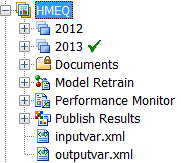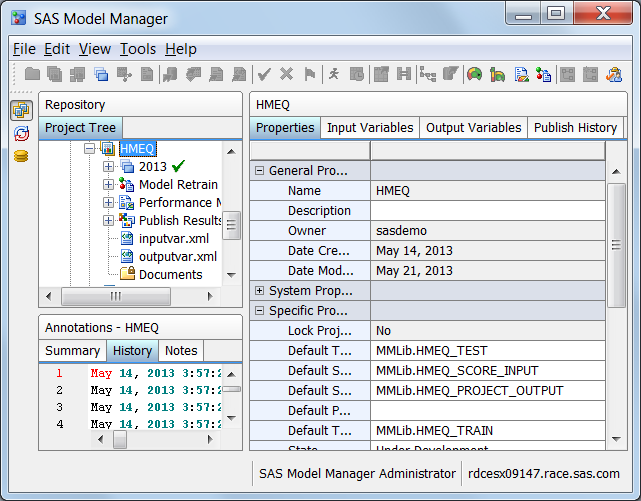Overview of Projects
What Is a SAS Model Manager Project?
A SAS Model Manager
project consists of the models, reports, documents, scoring tasks,
and other resources that you use to determine a champion model. For
example, a banking project might include models, data, and reports
that are used to determine the champion model for a home equity scoring
application. The home equity scoring application predicts whether
a bank customer is an acceptable risk for granting a home equity loan.
Project work is organized
in one or more time-based intervals that are called versions. Each
version contains the documents, models, reports, resources, scoring
tasks, and performance information for a time interval. Each version
can have its own life cycle definition for tracking the progress of
a project. For more information, see Working with Versions.
Multiple projects can
be created within a project control group. Some project tasks cannot
be performed for the projects that are within a project control group. For more information,
see Overview of Project Control Groups.
How a Project Folder Is Organized
The SAS Model Manager
project is a folder that contains versions, an optional Documents folder
a Model Retrain folder, a Performance
Monitor folder, a Publish Results folder,
and the project input and output XML files. Here is the Project Tree
view of a project:
Here is a description
of project folder components:
versions
are time-phased containers
for your project. They contain life cycle information, candidate model
files, model comparison reports, resource files, scoring tasks, and
model performance reports. This Project Tree has two versions, 2012 and 2013.
Performance Monitor
is used to execute
the SAS code that creates the performance monitoring report data sets.
inputvar.xml
is an XML file that
contains information about the project input variables and their attributes.
This file is based on the project input variables that are defined
when you create a project, modify a project, or declare a champion
or challenger model.
outputvar.xml
is an XML file that
contains information about the project output variables and their
attributes. This file is based on the project output variables that
are defined when you create a project, modify a project, or declare
a champion or challenger model.
Project Folder Tasks
When you right-click
the project folder, SAS Model Manager provides the following project
tasks:
New Version
creates a new time-phased
version to contain life cycle information, candidate model files,
model comparison reports, resource files, scoring tasks, and model
performance reports. For more information, see Create a Version.
New Documents Folder
creates a new Documents folder
to contain auxiliary documents, such as project notes and schedules. For more information,
see Associate Documents with a Folder.
Lock Project Metadata
enables a SAS Model
Manager administrator to lock the project metadata so that the project
definition cannot be modified while it is locked. For more information,
see Lock or Unlock Project Metadata.
Modify Project Definition
enables a user to modify
the project properties and the project input and output table variables
for the selected project. For more
information, see Modify Project Definition.
Publish Models to a Database
transforms DATA step
score code of a model to a scoring function or model scoring files,
and writes them to the database. For more
information, see Publishing Models to a Database.
Publish Models to a SAS Channel
publishes models to
defined channels, and notifies subscribers of the publication channel
when the models are delivered. For more information,
see Publish a Model to a Channel.
Publish Models to the SAS Metadata Repository
publishes the champion
model to the SAS Metadata Repository in order for the champion model
to be run in a test or production scoring environment. For more information,
see Publish Models to the SAS Metadata Repository.
Define Performance Task
starts a wizard that
generates the SAS code to monitor the performance of a champion model
or challenger model. For more information, see Overview of Creating Reports Using a Performance Task.
Dashboard Report Definition
starts a wizard to
create performance indicators that are used to execute the dashboard
reports. For
more information, see Create a Dashboard Report Definition.
Define Model Retrain Task
starts a wizard that
retrains one or more models. For more information,
see Retraining Models.
Define Aggregated Report
specifies reports from
the Reports folder that are used to create
a single aggregated report. For more information,
see Aggregated Reports.
Query
searches for models
and tasks that are assigned to SAS Model Manager users. For more information,
see Overview of the Query Utility.
Project Metadata
When you click on a
project folder, the detail view on the right has tabs that categorize
the project metadata:
-
The Properties tab shows the general metadata for the project. For more information, see Project Properties.
-
The Publish History tab shows the models that have been published to a database, a SAS channel or to the SAS Metadata Repository. The metadata includes the published name, the destination, the method of publishing, the server name, the user ID that published the model, the date on which the model was published, the model function, whether the model is a champion model or a challenger model, the project name, the version name, the model name, and the model level.
Copyright © SAS Institute Inc. All rights reserved.

